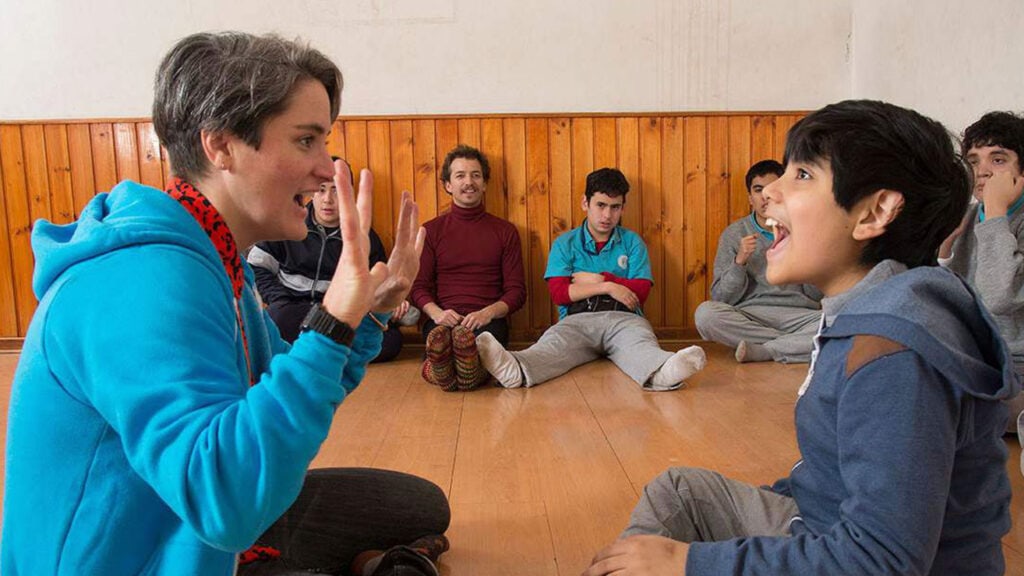Started as a musical experiment, by experimental musicians first, led by Marcelo Maira, Sound Simulation has been developed into a complex program of working with children, parents, and teachers through a multidisciplinary approach. Through play as a learning process, corporal consciousness, sensorial development, deep listening, and the development of bonds between each other, they give concrete tools for the development of new language codes to improve the life quality of people.
Sound stimulation has proven to be a successful methodology to develop social skills and increase the autonomy of children, especially those with an autism spectrum disorder. Sounds, music, and bodily movements are inclusion elements as all children enjoy and benefit from them. It is part of a contemporary approach to inclusive education, focusing on creativity, innovation, and playfulness.
The program has been ongoing and developing for 8 years. Interest in the program has increased. They started off by offering services to special schools, but by now it has also reached general education. Through their teacher training branch, they are helping to lay the foundations for inclusive education in Chile by incentivizing the collaboration of teachers working with general student populations and those working in special schools.
Using everyday objects and simple musical instruments, in a space that makes all kinds of movements possible, the foundation implements a series of sessions repeated every week. It is aiming at students to experiment and innovate using these objects and their bodies to create sound (in reality a lot of noise, too), and to build their own sound and bodily language. Throughout the year, the team is also conducting research to monitor the personal development of students in 12 areas.
The sessions vary according to the participants, but basically, they work the session in 3 parts. The first part is dedicated to activating the energy of the bodies with somatic exercises, to decompress the liquid of the central nervous system, allowing the participants to enter their bodies, leaving them in a state of alertness, a favorable state. This is a good basis for the next stage when they work with sound and on bodily development (it includes working on space and environment). The final phase is to do relaxation and meditation activities. Throughout these years they have found that, through this state of relaxation and deep listening, the knowledge and experience acquired enters the subconscious and affects the whole body.
Students show significant development in the following fields: sensory integration, life competencies, autonomy, development of communicational skills and new forms of language, as well as creating strong meaningful bonds with attuned adults.
While teachers regularly participate in these sessions. the foundation also offers a ‘Saturday School’ for teachers to train them in the methodology and make them multipliers.
As the program became more systemic, it has also led to a more systemic approach to organization. First, the program was offered by an informal structure that has been transformed into an educational foundation by now. The program has been implemented now also in Germany and the Netherlands.
The program mostly needs the support and commitment of the school management hosting the program. Teachers and parents play a key role in successful implementation, partly by accepting it as a successful methodology, partly by participating in it, and in the case of teachers by becoming multipliers dedicating free time to training.
In the past 5 to 10 years there has been a substantial increase in the diagnosis of people with Autism in Chile, and there is also an overdiagnosis of people with some type of special education need or disability since public education institutions receive extra funding for children with a diagnosis. There has been an increase of malfunction in this field as there are schools or school heads who fall into this diagnostic envelope to receive more state funding which means in some cases they simply claim money and in a high number of cases misuse these resources.
The center of their work is the Santiago and Valparaiso areas in Chile. Children participating in the program attend both public and private schools, so their socio-economic characteristics are diverse. The common ground is that they are informal education as the program is provided in schools. The program has reached about 2000 students and 1200 teachers from public education children in the past 8 years, but they hope to reach more through the teachers trained. Chile has a growing population with nearly 4 million children.
The foundation´s website is available here: http://fundacioncai.net/en/home-en/
Find more information here in Spanish:
